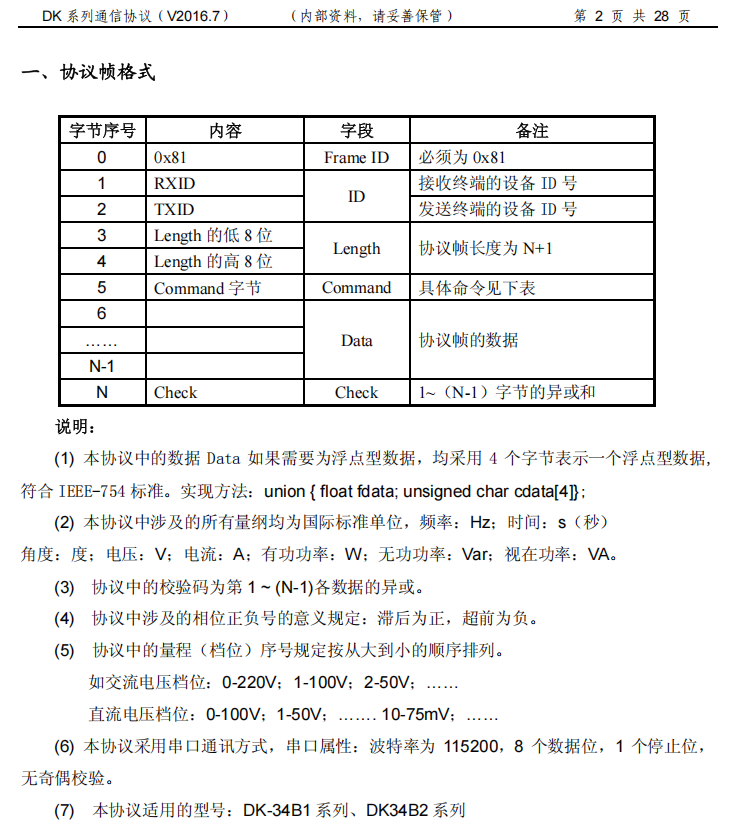复制代码
# DK 信号源 DK.py文件
import operator
from functools import reduce
import struct
import serial
import time
from PyQt5.QtCore import QByteArray, QIODevice
import binascii
class DK:
RS232_Command = {
'getOs': b'\x81\x00\x00\x07\x00\x4C\x4B', #获取信号源参数
'closeJLiu': b'\x81\x00\x00\x07\x00\x4F\x48', #关闭交流源
'openJLiu' : b'\x81\x00\x00\x07\x00\x54\x53', #打开交流源
'openZLDY':b'\x81\x00\x00\x08\x00\x67\x55\x3a',# 打开直流源-电压
'openZLDL':b'\x81\x00\x00\x08\x00\x67\x49\x26',# 打开直流源-电流
'setZLDY':b'\x81\x00\x00\x09\x00\x66\xff\x55\xc5', #设置直流电压参数
'setZLDL':b'\x81\x00\x00\x09\x00\x66\xff\x49\xd9', #设置直流电流参数
'closeZLDY':b'\x81\x00\x00\x08\x00\x68\x55\x35', #关闭直流电压源
'closeZLDL':b'\x81\x00\x00\x08\x00\x68\x49\x29', #关闭直流电流源
#切换 直流显示界面 12-30
'openZLUI':b'\x81\x00\x00\x08\x00\x4A\x06\x44',
#切换 交流显示界面
'openJLUI':b'\x81\x00\x00\x08\x00\x4A\x01\x43',
# 显示主界面
'openMainUI': b'\x81\x00\x00\x08\x00\x4A\x00\x42'
}
btl=115200 #波特率
def __init__(self,COM) -> None:
self.COM=COM
pass
#测试信号源的连接
def Test(self):
self.ser1.write(self.RS232_Command['getOs'])
data = self.ser1.readline() # 读取一行数据
return str(data)
#串口连接
def ConnectS(self):
self.ser1 = serial.Serial(self.COM,self.btl)
time.sleep(1)
if self.ser1.isOpen(): # 判断串口是否成功打开
print("打开串口成功。")
return True
else:
print("打开串口失败。")
return False
pass
# 串口关闭
def CloseSer(self):
self.ser1.close()
pass
def split_int_to_high_low_bytes(self,num):
"""
将一个整数分割成高八位和低八位。
Returns:
一个元组,包含高八位和低八位的十六进制表示。
"""
# 将整数转换为二进制字符串,并补全位数
binary_str = bin(num)[2:].zfill(8)
# 分割高低八位
high_part = binary_str[:4]
low_part = binary_str[4:]
# 转换为十六进制
high_hex = hex(int(high_part, 2))[2:]
low_hex = hex(int(low_part, 2))[2:]
return high_hex, low_hex
# 将list中数据依次异或
def xor_sum(self,arr):
return reduce(operator.xor, arr)
# 浮点数打包成四个字节
def float_to_hex(self,f):
# 将浮点数打包成4个字节
packed = struct.pack('f', f)
# 将字节转换为十六进制字符串
hex_str = ''.join('{:02x}'.format(x) for x in packed)
# 每两个字符一组,并用空格分隔
hex_groups = ' '.join(hex_str[i:i+2] for i in range(0, len(hex_str), 2))
return hex_groups
def hex_to_decimal(self,hex_string):
"""将十六进制字符串转换为十进制数列表"""
hex_list = hex_string.split()
decimal_list = [int(hex_num, 16) for hex_num in hex_list]
return decimal_list
# =====================================================
# 直流 设置
#关闭直流源电流
def closeZLDL(self):
self.ser1.write(self.RS232_Command['closeZLDL'])
# 关闭直流源电压
def closeZLDY(self):
self.ser1.write(self.RS232_Command['closeZLDY'])
# 打开直流设置直流电流
def openZLDL(self):
self.ser1.write(self.RS232_Command['openMainUI'])
time.sleep(1)
self.ser1.write(self.RS232_Command['openZLUI']) #12-28新增切换ui
time.sleep(1)
self.ser1.write(self.RS232_Command['openZLDL'])
time.sleep(1)
self.ser1.write(self.RS232_Command['setZLDL'])
time.sleep(2) #打开后必须等五秒再发电流大小
pass
# 打开直流设置直流电压
def openZLDY(self):
self.ser1.write(self.RS232_Command['openMainUI'])
time.sleep(1)
self.ser1.write(self.RS232_Command['openZLUI']) #12-28新增切换ui
time.sleep(1)
self.ser1.write(self.RS232_Command['openZLDY'])
time.sleep(1)
self.ser1.write(self.RS232_Command['setZLDY'])
time.sleep(2) #打开后必须等五秒再发电流大小
pass
# 写入直流值 val1 写入的值 val2是0x55为电压 0x49为电流
def writeZL(self , value, value2):
floats = self.hex_to_decimal( self.float_to_hex(value))
command=[0x0,0x0,0xd,0x0,0x69,0xFF]
for f in floats:
command.append(f)
command.append( value2 )
checked = self.xor_sum(command)
command.append( checked )
commands="129 "
for comm in command:
commands=commands+str(comm)+' '
# print(commands)
# return commands
commandstr = commands.split(' ')
numbers =[]
for comm in commandstr[0:13]:
numbers.append( int(comm))
my_bytes = bytes(numbers[0:13])
self.ser1.write(my_bytes)
return numbers[0:13]
# =====================================================
# 交流 设置
#打开交流
def openJL(self):
self.ser1.write(self.RS232_Command['openMainUI'])
time.sleep(1)
self.ser1.write(self.RS232_Command['openJLUI']) #12-28新增切换ui
time.sleep(1)
self.ser1.write(self.RS232_Command['openJLiu'])
time.sleep(1)
# 关闭交流源
def closeJL(self):
self.ser1.write(self.RS232_Command['closeJLiu'])
time.sleep(1)
# 写入交流电压的值
def writeJLDY(self , value):
length=11
floats = self.hex_to_decimal( self.float_to_hex(value))
command=[0x0,0x0,length,0x0,0x32 ]
for f in floats:
command.append(f)
checked = self.xor_sum(command)
command.append( checked )
commands="129 "
for comm in command:
commands=commands+str(comm)+' '
commandstr = commands.split(' ')
numbers =[]
for comm in commandstr[0:length]:
numbers.append( int(comm))
# for r in numbers:
# print(hex(r))
my_bytes = bytes(numbers[0:length])
self.ser1.write(my_bytes)
return numbers[0:length]
# 添加交流电流
def writeJLDL(self , value):
length=31
floats = self.hex_to_decimal( self.float_to_hex(value))
command=[0x0,0x0,length,0x0,0x32 ]
for i in range(0,12):
command.append(0x00)
for f in floats: #添加交流电流值
command.append(f)
for i in range(0,8):
command.append(0)
checked = self.xor_sum(command) #计算最后一位的出校验位
command.append( checked ) #把校验位添加到末尾
commands="129 " #所有命令的头部肯定都是0x81==129
for comm in command:
commands=commands+str(comm)+' '
commandstr = commands.split(' ')
numbers =[]
for comm in commandstr[0:length]:
numbers.append( int(comm))
my_bytes = bytes(numbers[0:length]) #转换成字节数组发送出去
self.ser1.write(my_bytes)
return numbers[0:length]
